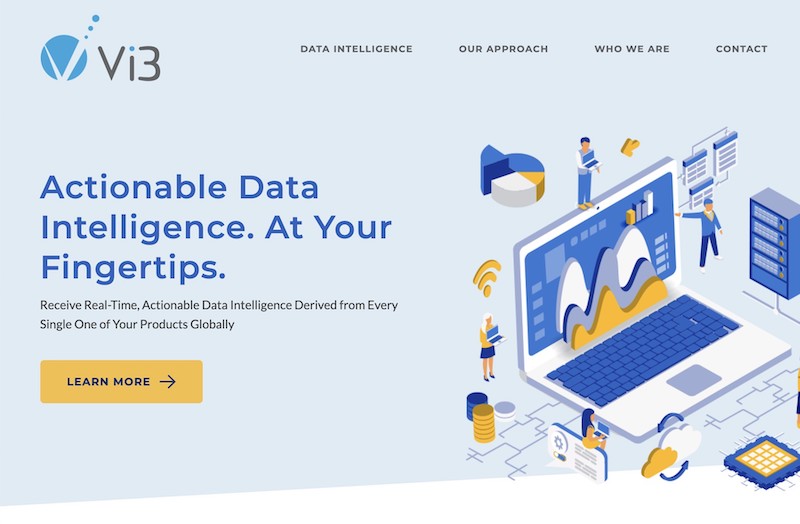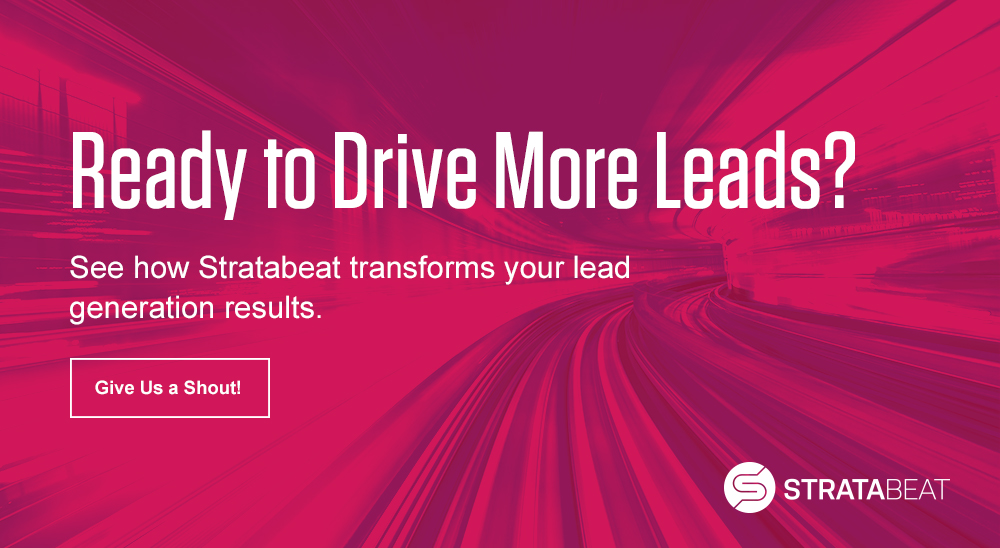The Top Lead Generation Trends of 2020

B2B marketing centers on lead generation. The more high quality leads you drive, the more your CEO is cranking up their Spotify playlist and doing the moonwalk as they party down.
With lead gen methods and tactics continually evolving, it’s important to stay on top of the latest lead generation trends. By understanding not only what’s effective today, but what will be critical lead generation trends moving forward, you can take your leads volume to new heights in 2020.
With that in mind, here are a few of the most important trends to focus on to ensure you surpass your lead generation goals in 2020.
Email Marketing (Still a Lead Gen Powerhouse)
Leading our list of lead generation trends for the coming year is email marketing. As it has for years, email is a cornerstone of B2B marketing. According to HubSpot, 83% of B2B companies use email newsletters as part of their content marketing while more than 59% of marketers confirm that email is their biggest source of ROI.
Email makes money. For every dollar spent on email marketing, marketers achieve an average ROI of $44, according to CampaignMonitor.
Email marketing drives not only customer acquisition, but 80% of marketers state it also delivers the added benefit of enhanced customer retention.
According to Chief Marketer’s 2020 B2B Marketing Outlook Survey, email has been the top source for B2B leads and has the highest return on investment (ROI).
The verdict is in. If you want more leads, you should be heavily engaged in email marketing.
More Sophisticated Account-Based Marketing (ABM)
Account-based marketing (ABM) is a strategy for growth by focusing on best-fit prospects and customers. With ABM, it’s about quality, not quantity. It’s about targeting, not inbound. It’s about identifying your best prospects and customizing a campaign or program specifically for each account. More than 90% of B2B marketers acknowledge account-based marketing as either important or very important (Source: SiriusDecisions).
If you’re looking for lead generation ROI, ABM is it. Research by ITSMA found that 87% of marketers that measure ROI confirm that ABM outperforms every other marketing investment.
In a survey by Alterra Group, ABM had higher ROI than other marketing activities. According to SiriusDecisions, 91% of marketers that use ABM have experienced a larger average deal size, with 25% of those marketers achieving a deal size over 50% larger.
With results like these, expect ABM adoption to only intensify in 2020 as another key lead generation trend.
Land Bigger Fish through ABM
Uncover strategies to use ABM to engage with your best prospects. Give Us a Shout!
Long-Form Content
If you want to expand your reach online, you’d be hard pressed to find a more effective vehicle than SEO. After all, with organic search your audience is finding you at the precise time that they are seeking information, answers or products. According to Chief Marketer’s 2020 B2B Marketing Outlook Survey, SEO is the second best channel for lead generation ROI, while content marketing was rated the third best channel (only behind email marketing).
SEO has been popular with many firms for more than a decade, but what’s new is the steep rise in the number of companies creating exceptional quality with long-form content.
And it works!
Case in point, Stratabeat helped one client rank for 273 keywords on Google page one and two this past year through long-form content. For another, we increased organic blog page views by 196%. Even for ourselves, we’re now on Google page one for branding terms including “b2b branding,” “b2b rebranding,” “rebranding strategy/strategies,” “branding ROI,” “b2b brand,” “b2b rebranding strategy/strategies,” among others.
Unique Research
BuzzSumo has confirmed that its most successful content has been related to its unique research. There are many reasons why unique research produces such solid marketing results, not the least of which is that it’s proprietary and therefore delivers new value to readers.
And unique research is effective in driving leads.
For one client, our unique research for them resulted in five national TV appearances, not to mention coverage in prominent online publications and the best performing posts of their blog. For another client our industry trends research drove more than 150 webinar registrants not to mention many additional downloads from their website. Stratabeat’s own research into B2B websites has led to various speaking and PR wins, as well.
Podcasting
There are currently more than 700K podcasts and more than 29 million podcast episodes available, compared with 550,000 and 18.5 million respectively just two years ago, indicating strong growth for podcasting.
Of the U.S. population, 90 million have listened to a podcast in the last month and 22 million in the last week, according to Edison Research and Triton Digital. The report states that there are 17 million more monthly podcast listeners and 14 million more weekly podcast listeners than in 2018. Weekly podcast listeners average seven podcasts per week.
Approximately 13 million households include avid fans of business podcasts (52 million households for casual fans).
And ad dollars make the case that podcasting is here to stay. From 2016 to 2019, branded content by businesses jumped from 1.5% to 10.1% of overall podcast advertising, which is projected to increase to $659 million in 2020 (up from $314 million in 2017 and $497 million in 2018).
Podcasting is on the rise. Be sure to explore it as one of your lead generation options in 2020.
Land More Leads through LinkedIn
Uncover strategies to use LinkedIn to engage with your best prospects. Give Us a Shout!
LinkedIn Marketing
LinkedIn boasts more than 30 million companies and 660 million members (181 million in North America alone) on the platform. According to LinkedIn and Salesforce, the LinkedIn audience has 2X the buying power of the average web audience.
LinkedIn is an especially good source for generating leads, as it’s effective in the B2B space and offers a range of targeting options including lookalike audiences as well as targeting based on industry, company, job title, seniority, LinkedIn Group, geography, interests and more. You can even target an existing database of emails. According to the 2020 Chief Marketer B2B Marketing Outlook Survey, LinkedIn is the most effective social media channel for driving B2B leads.
Specifically, 79% of B2B marketers see LinkedIn as an “effective source for generating leads.” In fact, HubSpot found that LinkedIn is 277% more effective at generating leads than Facebook and Twitter.
LinkedIn is so effective for lead generation that 70% of B2B marketers are planning on increasing their organic activities on the platform moving forward. And this is why the platform is included on our list of top lead generation trends.
Increased Personalization
Expect all aspects of B2B marketing in 2020 to start zeroing in on targeted audiences and personas to increase lead generation rates. Sixty-percent (60%) of marketers feel that personalization is a key strategy for improving the quality of their leads.
Evergage reports that 50% of the marketers they surveyed are motivated by the power of personalization to increase lift/ROI.
Proving this point, advanced personalization has an ROI of approximately $20 for every $1 spent according to a study by The Relevancy Group. The CEB found that individual stakeholders in a consensus B2B sale who perceived supplier content to be customized to their needs were 40% more willing to buy from that supplier than other options who didn’t. Accenture research revealed that 73% of B2B buyers want a personalized, B2C-like customer experience.
However, Evergage found that only 12% of marketers are currently “very” or “extremely” satisfied with the level of personalization in their marketing efforts. Meaning, there’s plenty of room for growth in the coming years.
Transforming Your Blog Into a Lead Generation Engine
Video Marketing
Among lead generation trends, B2B video marketing is absolutely crushing it! More than one billion hours of video is watched every day now on YouTube.
B2B buyers are increasingly consulting videos during the purchase process, whether webinars, webcasts, demos, live streams, or short, informational videos on websites and social media, and the numbers prove this out.
According to Wyzowl research, 92% of marketers who use video say that it’s an important part of their marketing strategy. The reasons are clear. Video marketers generate 66% more qualified leads per year, according to Aberdeen Group. More than 80% of B2B and B2C marketers believe that video not only leads to views, but also engagement and conversions.
LinkedIn, especially, has finally started to catch up with the video marketing trend. The LinkedIn “video revolution” began in 2018, and will continue to grow in 2020. In Stratabeat’s own experience with our clients as well as our own experience on LinkedIn, video posts generate 3X-5X the engagement of other posts on the platform.
Broader Use of Influencers
Historically, influencer marketing has largely been the domain of B2C companies. However, more and more B2B companies are jumping on the trend. Businesses are partnering with relevant influencers in order to extend their reach and gain an authentic voice in front of passionate, engaged communities.
According to the World Federation of Advertisers, 65% of multinational brands plan to increase their influencer marketing spending within the coming year. In Demand Gen Report’s 2019 Content Preferences Survey, 95% of respondents state that they favor credible content from industry influencers as a top preference (a jump of 30% over the prior year).
Although not the biggest or most important lead generation trend, expect more B2B companies to enter into strategic partnerships with influencers in 2020.
Modern Web Design
Underscoring the importance of your website as your most critical marketing asset, companies are now investing more in their website than any other channel or marketing program according to Gartner’s Annual CMO Spend Research 2019-2020 Webinar.
Conducting demand generation campaigns is critical to a successful marketing program, but if your B2B website is outdated it means that not only are you losing potential prospects when they are on your site but that you are also wasting your demand gen dollars. It’s a double loss.
Whether you’re conducting email marketing campaigns or generating amazing videos or “all in” on SEO and long-form content, it’s your website that ultimately needs to convert your audience. If you want more leads, invest in upgrading your website. You’ll be thankful you did.
Transforming Your Website Into a Lead Generation Engine
Achieve accelerated growth through a more powerful & effective website. Let’s Talk!
Customer Data Platforms
With modern day B2B marketing, your team is most likely grappling with a number of disparate systems and consequently spending a frustrating amount of time on workarounds. With so much data, it’s difficult getting a consolidated, holistic picture of the “customer truth.”
The solution? A customer data platform (CDP).
What this does is consolidate your website analytics, marketing automation data, CRM data, search data, social media analytics and other data sources to build a unified customer profile. This type of more comprehensive profile enables you to deliver more accurate and effective segmentation, messaging and reporting.
With the explosion in marketing technology and data (see the next trend, below), a greater number of companies are realizing the need to integrate all this new data for deeper insights.
To that end, expect an intensified focus on CDPs in the coming year (and years).
Explosion in Marketing Technology
Almost two-thirds (61%) of CMOs expect their marketing budget to increase in 2020, according to Gartner’s Annual CMO Spend Research 2019-2020 Webinar.
A greater share of that budget will be going to marketing technology. Worldwide spend on marketing technology is $121.5 billion, according to the Martech: 2020 and Beyond report by BDO, WARC, and the University of Bristol. Companies in North America increased the percentage of their marketing budget dedicated to marketing technology by 114% from 2017 to 2019.
There are now 7,040 solutions available across the marketing technology landscape, as documented in Scott Brinker’s annual martech ecosystem analysis. For perspective, there were merely 947 solutions in 2014, marking 5-year growth of 643%.
Brinker points out that a major shift in the landscape is the evolution of the major marketing suites becoming true marketing platforms, with open APIs and a marketplace of third-party apps. Think of Salesforce, Adobe, HubSpot, Microsoft and G Suite as examples of this.
Summary: Lead Generation Trends
From email marketing to LinkedIn marketing and the modernization of websites, your team should look to capitalize on these lead generation trends in 2020 in order to maximize your leads and growth in the coming year.
A summary of our list of lead generation trends:
- Email Marketing
- Account-Based Marketing (ABM)
- Long-Form Content
- Unique Research
- Podcasting
- LinkedIn Marketing
- Personalization
- Influencers
- Modern Web Design
- Customer Data Platforms
- Marketing Technology







